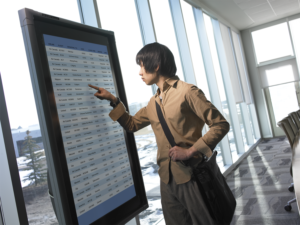
Digital signage is an important element in all types of facilities, from hospitals to schools to gymnasiums. This type of signage allows facilities to provide dynamic information that can be changed based on their needs. On the other hand, wayfinding refers to how people orient themselves while in a building or complex. While digital signage and wayfinding often go hand-in-hand, what we know about digital signage vs wayfinding is that digital signage can encompass more than just wayfinding technology.
An Explanation Of Wayfinding And Digital Signage
Digital signage is a broad category that encompasses all kinds of signs that use LED, LCD, or projection technology to display text, images, and video. Digital signage has been in use for many years, especially in metropolitan areas like the Times Square section of New York City and the Las Vegas strip. Digital signage is also used by restaurants, retail stores, and sports stadiums as a way to interact with their patrons and provide customizable information.
Wayfinding, more specifically, is a type of digital signage and process that helps people find their way in a given location. It is used in numerous large public places including larger healthcare facilities like hospitals and surgical centers and higher education and large museums. One such case is how wayfinding was implemented at the Smithsonian National Museum of Natural History. The museum, located in Washington, D.C., receives about 7.5 million visitors annually. Its help desk was becoming overwhelmed with inquiries that could have been answered easily with proper signage. As this platform evolves, we will experience more portable applications that allow people to engage in wayfinding, using devices they carry themselves as they navigate.
The Importance of Digital Signage And Wayfinding
Some digital signs are implemented for advertising purposes, or to convey information. For example, digital signage might be used at a public transit stop to let passengers know how long it will be until the next train or bus arrives. Marquees on digital signage can be used to give people the latest breaking news or weather updates.]
As mentioned earlier, wayfinding provides navigation and direction in large, public areas. On top of that, wayfinding can gather important data and metrics for organizations.
You can easily find a digital signage system that helps with your wayfinding needs as well, similar to the system installed at the Smithsonian Museum of Natural History. Digital signage with wayfinding capabilities will improve the way that you communicate with people in your facility and add a touch of modernity to your space. The key to success with both digital signage and wayfinding is applying these concepts in a way that makes sense based on your needs.
Talk to Us About Your Project
Too busy to chat right now?
Send us a message.


